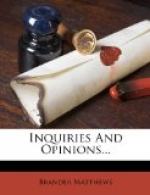This distinction between imagination and invention may not be as important as that between imagination and fancy urged by Wordsworth a century ago; and no doubt there is always danger in any undue insistence upon catchwords, which are often empty of meaning, and which are sometimes employed to convey a misleading suggestion. This distinction has its own importance, however, and it is not empty or misleading. It needs to be accepted in art as it has been accepted in science, in which domain a fertile discovery is recognized as possible only to the imagination, while a specific device is spoken of as an invention. Newton and Darwin were discoverers by their possession of imagination; whereas the telegraph and the telephone are to be credited to humbler inventors, making application of principles already discovered.
This opening century of ours is an era of extraordinary dexterity and of wide-spread cleverness, and we need to be put on our guard against the risk of mistaking the products of our abundant invention for the rarer gifts of inspiring imagination. It is well for us to be reminded now and again that the great masters, painters and poets alike, novelists and dramatists, have often displayed “a sluggish avoidance of needless invention” at the very minute when their robust imagination was putting forth its full strength.
(1904.)
POE AND THE DETECTIVE-STORY
I
In one of those essays which were often as speculative and suggestive as he claimed, the late John Addington Symonds called attention to three successive phases of criticism, pointing out that the critics had first set up as judges, delivering opinions from the bench and never hesitating to put on the black cap; that then they had changed into showmen, dwelling chiefly on the beauties of the masterpieces they were exhibiting; and that finally, and only very recently, they had become natural historians, studying “each object in relation to its antecedents and its consequences” and making themselves acquainted “with the conditions under which the artist grew, the habits of his race, the opinions of his age, his physiological and psychological peculiarities.” And Symonds might have added that it is only in this latest phase, when the critics have availed themselves of the methods of the comparative biologists, that they are concerned with the interesting problems connected with the origin of the several literary species.
All over the world to-day devoted students are working at the hidden history of the lyric, for example, and of certain subdivisions of this species, such as the elegy, as it flowered long ago in Greece and as it has flourished in most of the literatures of modern Europe. To the “natural historian” of literary art, these subdivisions of a species are becoming more and more interesting, as he perceives




